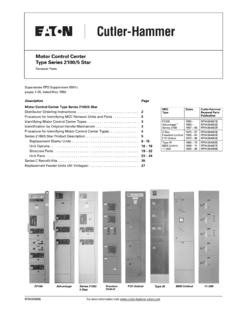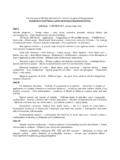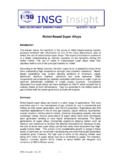Transcription of Silica Fume
1 Silica fume By Gary M. Gapinski and John Scanlon In the Refractories world thirty- five years ago, no one was working with Silica fume and few knew what it was. Within a few years, it was being used as an additive to brick. When added to high Alumina brick, mullite was formed in the matrix of the brick on firing, giving the brick good volume stability, strength and chemical resistance. When used in basic brick, high hot strengths resulted, at least at 2700 F, which was about the limit of what could be tested. At the time it was only logical that Silica fume would be used in brick not castables. Brick were used for all critical applications, no one would have considered using castables. Today s refractory castables have gone beyond having brick-like properties to actually out performing brick in many applications.
2 Silica fume has played a major role in this transformation. History The history of Silica fume is relatively short, the first recorded testing of Silica fume in Portland cement based concretes was in 1952 and it wasn t until the early 1970 s that concretes containing Silica fume came into even limited use. The biggest drawback to discovering the unique properties of Silica fume and its potential was a lack of Silica fume to experiment with. Early research used an expensive additive called Fumed Silica , a colloidal form of Silica made by combustion of silicon tetrachloride in hydrogen-oxygen furnaces. Silica fume on the other hand, is a by-product or a very fine pozzolanic material, composed of mostly amorphous Silica produced by electric arc furnaces during the production of elemental silicon or ferro silicon alloys.
3 Before the late 1960 s in Europe and the mid1970 s in the United States, Silica fume simply went up the stack as smoke vented into the atmosphere (Illustration #1). Illustration # 1 1 Only with the implementation of tougher environmental laws during the mid-1970 s did silicon smelters begin to capture and collect the Silica fume , instead of sending it to the landfill. Thus the push was on to find uses for it. Obviously, the early work done in Norway received most of the attention, since it had shown that Portland cement based concretes containing Silica fumes had very high strengths and low porosities. Since then Silica fume usage and development has continued making it one of the world s most valuable and versatile admixtures for concrete and cementitous products.
4 Typically purchased by the refractory market in a 50 lb. bag this very fine gray powder (Illustration #2) has come along way from being known only as smoke . Illustration # 2 Silicon Smelting To understand Silica fume , one must first understand the smelting of silicon metal. Silicon is smelted in large submerged arc electric furnaces (Illustration # 3). A typical 20 MW furnace might be as large as 40 feet in diameter and 15 feet deep. There are 3 electrodes, which could be up to 60 inches in diameter. Illustration # 3 2 The furnace charge is quartzite, charcoal, wood chips and coal. The quartzite used for smelting silicon must be very pure and contain more than 99% silicon dioxide. The quartzite is usually river rock that has been very carefully washed to remove any fines.
5 Typically, this rock is between 1 and 4 inches in diameter. The coal must also be very pure and washed to remove any fines. Alkalies and iron are undesirable tramp elements. The proper ratio of coal, quartzite, wood chips and charcoal are continuously added to the top of the furnace while silicon metal is tapped from the bottom. The coal, charcoal and wood chips provide an extremely reducing atmosphere near the bottom of the furnace and especially around the ends of the electrodes. Hot gases rising through the burden preheat it and the extreme temperature at the tips of the electrodes volatilizes the quartzite when it gets close to them. This silicon dioxide vapor reacts with the now porous, pure carbon to form carbon monoxide, silicon monoxide, silicon carbide and eventually silicon metal. The carbon monoxide gas rises through the burden and oxidizes to form carbon dioxide at the top of the furnace, where the atmosphere is oxidizing.
6 More than three pounds of carbon monoxide are produced for each pound of silicon. Just like the carbon monoxide, silicon monoxide gas also rises through the burden. If the porous carbon phases don t strip away the last oxygen molecule, the silicon monoxide will eventually reach the oxidizing zone. While the carbon in the reducing zone of the furnace strips the oxygen from most of the silicon monoxide, some of it does escapes to the upper reaches of the furnace and the reaction of silicon monoxide to silicon dioxide gives us Silica fume . The Silica fume that reaches the top of the furnace is sucked up into the hood that covers the top of the furnace by powerful bag house fans (Illustration # 4). Illustration # 4 In order to meet very stringent environmental regulations, the bag house fans need to provide enough of a vacuuming action at the top of the furnace, so that no gases escape into the atmosphere and this does cause some problems.
7 One of the reasons that the quartzite and coal are washed to remove the fines is so there will be no fines to be swept up the stack with the fume . Obviously, there are some fines still present and they do get pulled up the stack. For the silicon smelter, this isn t a problem. But for Silica fume consumers an excessive presence of fine quartzite and coal contaminants places the end 3product outside of specification limits. These are tramp elements or oversize materials that you don t want in your Silica fume . On the other hand, what does concern the silicon smelters is that partially ignited wood chips, are also routinely pulled up the stack. Smoldering wood chips and bag houses just don t mix, so we have to separate the coal fines, quartzite fines, and wood chips, better known as Heavies from the Silica fume .
8 This is done first in the coolers and then in a series of cyclones that drop out all of the Heavies . After this cleaning and cooling operation, Silica fume is captured on the bags in the bag houses (Illustration # 5). The bags can be shaken or the compartment of the bag house backwashed to knock the fume from the bags. The fume is then moved into a silo either pneumatically or with a screw conveyor. Illustration # 5 Processing and Handling Typically the plants will have two different silo setups, one is for the storage, bulk loading and packaging of undensified Silica fume and the other for the storage, bulk loading and packaging of densified Silica fume . Undensified Silica fume is the as is product that most Refractories use regularly, where as the densified product is made using undensified Silica fume and some additional processing steps.
9 The majority of densification silos have a very fine screen that covers the bottom section upon which the Silica fume rests. Air is blown into the silo under the screen. This air gently rises through the Silica fume causing the individual Silica particles to rub against each other. As the particles touch, the naturally occurring van der Waals forces on their surface cause the particles to be attracted to each other. This attraction causes the particles to adhere to each other. The longer the air is allowed to flow through the fume bed, the greater the degree of agglomeration and correspondingly the density. Once the desired density is reached, the airflow to the silo is stopped. The newly densified Silica fume can be shipped in bulk in pneumatic trucks, in super sacks or in small (usually 50 lb.)
10 Paper bags. The value of the densification process is most evident in shipments over long distances and especially for off shore customers because it greatly reduces the cost to transport 40 lbs/ft3 Silica fume versus 15 lbs/ft3 material. 4 The end use of Silica fume determines what form, densified or undensified, the consumer needs. The undensified fume in the bag house has a loose fill density of between 4 and 8 lbs/ft3 very similar to talcum powder. By the time the fume gets to the silo, moves to the bagger, is blown into the bag, the bags stacked onto a pallet and the pallet shipped to the customer, that density has increased to12 to18 lbs/ft3. Part of this density increase is due to the removal of air voids from between the individual Silica fume particles, during handling.








